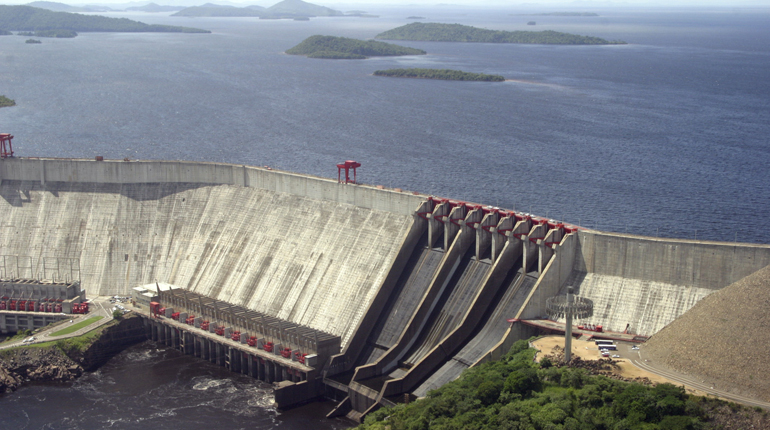 Water levels at Venezuela’s Guri dam are dropping close to the minimum needed for power production. (PA)
Water levels at Venezuela’s Guri dam are dropping close to the minimum needed for power production. (PA)
Venezuela is facing a critical week, with dry conditions caused by the El Niño weather phenomenon hammering the country’s hydroelectric production and threatening rolling blackouts.
The gas-to-power sector is likely to provide only modest relief because of the poor availability of thermoelectric plants, experts have told Interfax Natural Gas Daily.
Water levels at Venezuela’s 8.8 GW Guri hydroelectric power plant, which generates 60-70% of the country’s electricity, are continuing to fall. The reservoir level had fallen to 244.55 metres above sea level on 4 April, according to statistics from Corpoelec, the state-owned company that oversees Venezuela’s power sector.
There are fears that the level will dip below 240 metres, which is the minimum required for power production.
"We are already at the lower end of the emergency level range. If the reservoir reaches 240 metres, power authorities will have to shut down some generation units," Patricia Ventura, a director at energy consultancy IPD Latin America, told NGD on Monday.
"The government is facing some big decisions as water levels continue to fall to historical lows," said Ventura, who is also a professor of petroleum policy at the Universidad Metropolitana in Caracas.
Venezuelan authorities agreed during a previous power crisis in 2003 that they would not attempt to operate Guri below 244 metres because of the technical risk associated with such low water levels. "But now we question whether this is still the case," said Ventura.
Caracas has not formally announced a rationing programme. "If the level reaches 240 metres we will have to apply certain operative measures," Miguel Angel Romero, Corpoelec’s head of generation, told Reuters at the weekend. He did not provide further details.
Igor Hernández, coordinator of the Energy Centre at the Institute of Higher Administration Studies in Caracas, told NGD on Friday that the level of "total power collapse" could be closer to 230 metres.
Blackouts and rationing
"Either way, the country is facing significant blackouts and power rationing," said Ventura.
Caracas is aiming to boost thermoelectric generation to over 7 GW in the next few weeks, according to Romero. However, there are doubts about availability in the sector.
Venezuela has about 24 GW of generation capacity. Around 63% (15 GW) of this is hydroelectricity, including 8.8 GW from Guri alone, according to the most recent Corpoelec statistics, published in 2012.
Approximately 35% (8.4 GW) of available capacity is thermoelectric power, some of which is via gas-fired combined cycle units, while some is comprised of simple-cycle and steam units, which use both gas and diesel feedstock.
It is uncertain if around 5 GW of older thermal power capacity will be available, Jed Bailey, the managing partner of Energy Narrative, a Latin America-focused consultancy, told NGD.
Caracas claims to have added 3 GW of new thermal capacity between 2013-2015 and converted another 1.3 GW to gas. However, the Venezuelan authorities have also taken several ageing facilities offline, said Bailey.
"Even with the capacity additions, the 24 GW of claimed capacity today is well below the 27.7 GW reported in 2012," said Bailey. "Even if all thermal capacity was available, it would not be enough to meet peak demand of around 18.3 GW seen in 2012," he added.
Venezuela’s current total power demand is likely to be lower than in 2012 because of the country’s worsening economic situation. "But [its total power demand] is still likely to be roughly double the country’s available thermoelectric capacity," said Bailey.
"Thermal plants are ageing, and energy authorities have faced an uphill battle with maintenance," said Ventura. "Beyond generation capacity, there is also a deep structural deficit with transmission infrastructure."
"The most straightforward way of sharing the shortage is to have rolling blackouts where entire sections of the grid are removed from service for a few hours," said Bailey.
The Venezuelan government has not released any power sector data since 2013 and only publishes statistics on water levels at Guri. It is illegal in Venezuela to divulge information about the country’s power sector without permission.
"The lack of transparency in the power sector is a huge problem," said a source close to the situation, who wished to remain anonymous because of political sensitivities.
"You also need water inflow data [in addition to water level statistics] for an accurate assessment of hydroelectricity production, which is not available," added the source.
Ventura said Caracas was now putting its faith in the elements. "There is one crumb of hope – it has been raining since Saturday, so we will know more when Corpoelec updates their data."
Guri, the official name of which is the Central Hidroeléctrica Simón Bolívar, is situated on the Caroni River in Bolívar, Venezuela’s largest state, and is one of the world’s biggest hydroelectric dams.
Venezuela’s dry season usually runs from October until April – with January, February and March being the driest and hottest months. Venezuela suffered similar El Niño-related power crises in 2003 and 2009, when water levels at the Guri dam fell to 244.55 metres and 248.36 metres respectively.








Talk to us
Natural Gas Daily welcomes your comments. Email us at [email protected].